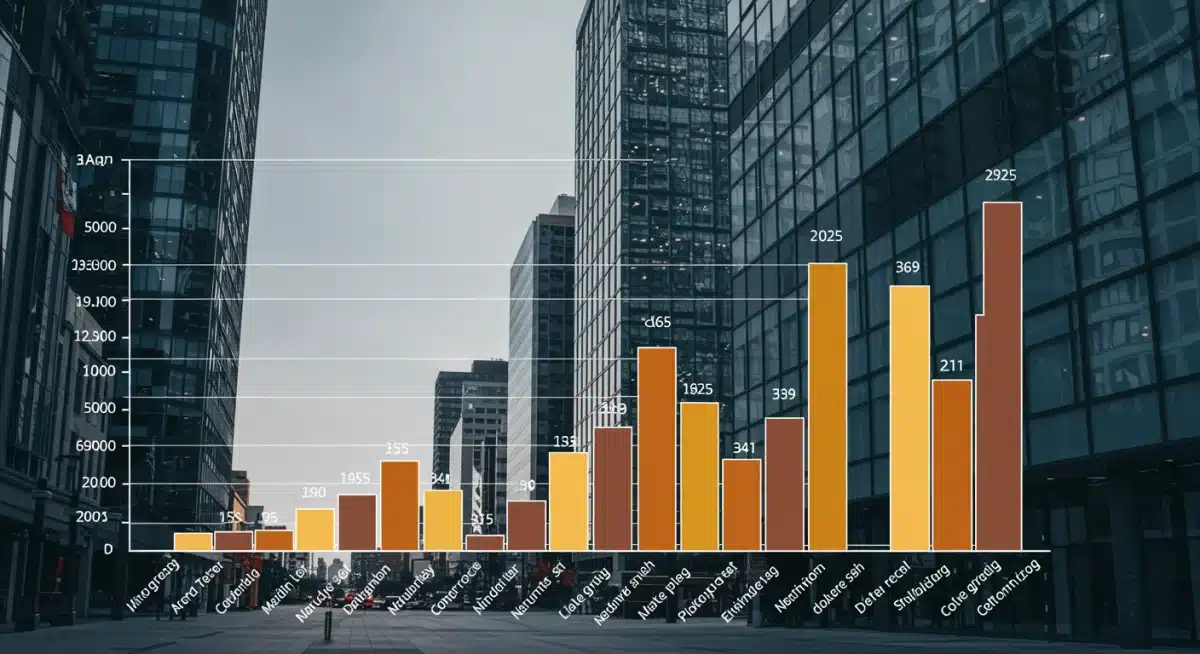2025 Buyer Demographics Shift: Market Impact & Recent Updates

Recent analyses confirm a looming 2025 buyer demographics shift, poised to significantly reshape market dynamics and consumer engagement strategies across various industries.
The landscape of consumer behavior is continuously evolving, and recent updates indicate a significant transformation on the horizon. Understanding the 2025 Shift in Buyer Demographics and Its Market Impact (RECENT UPDATES) is not just crucial but imperative for businesses aiming to stay competitive and relevant. What are these shifts, and how will they redefine success?
Generational Power Shifts: Millennials and Gen Z Dominance
As of late 2024, the influence of Millennials and Generation Z in the global marketplace continues its upward trajectory, accelerating towards a dominant position by 2025. This demographic transition is not merely a numbers game; it reflects a fundamental change in purchasing power, values, and preferred engagement channels.
Millennials, now firmly established in their careers, are increasingly moving into prime earning and spending years, particularly in housing, family-related products, and financial services. Gen Z, on the other hand, is rapidly entering the workforce, bringing with them a distinct set of digital-native expectations and a strong emphasis on brand authenticity and social responsibility.
The Rising Influence of Digital Natives
Both Millennials and Gen Z are digital natives, but their digital consumption habits differ. While Millennials are adept at navigating online platforms, Gen Z has grown up with social media, influencing their discovery, research, and purchasing decisions.
- Social Commerce: Gen Z’s strong preference for purchasing directly through social media platforms.
- Influencer Marketing: Authenticity and relatability from micro-influencers often resonate more than traditional celebrity endorsements.
- Mobile-First Experience: Expectation of seamless, intuitive experiences across all mobile devices for everything from browsing to customer service.
Businesses must recalibrate their digital strategies to meet these evolving demands. This includes investing in robust e-commerce platforms, optimizing for mobile, and developing compelling content for diverse social media channels. The shift requires more than just an online presence; it demands an integrated, personalized digital ecosystem.
Economic Realities and Shifting Spending Priorities
The economic climate continues to shape buyer behavior, with inflation, interest rates, and job market stability playing critical roles. Recent reports indicate that while consumer spending remains robust in some sectors, discretionary spending is under increased scrutiny, particularly among younger demographics.
In response to economic pressures, buyers are prioritizing value, durability, and experiences over sheer volume of purchases. This trend signifies a move away from impulse buying towards more considered, informed decisions. Brands that can clearly articulate their value proposition and demonstrate long-term benefits are gaining an edge.
Value Proposition Redefined
The definition of ‘value’ is expanding beyond just price. Consumers are increasingly factoring in environmental impact, ethical production, and brand transparency when making purchasing choices.
- Sustainability: Demand for eco-friendly products and sustainable business practices.
- Ethical Sourcing: Preference for brands that ensure fair labor practices and transparent supply chains.
- Longevity: Investment in durable goods that offer extended use and reduce waste.
Businesses are now challenged to not only offer competitive pricing but also to communicate their broader commitment to social and environmental responsibility. This shift requires a holistic approach, integrating these values into product development, marketing, and corporate operations. Transparency in communication builds trust and loyalty in a market where consumers are more discerning than ever before.
The Rise of the Conscious Consumer and Ethical Buying
The 2025 buyer is projected to be more conscious and ethically driven than previous generations. This is a direct consequence of increased global awareness, access to information, and a desire to align purchasing decisions with personal values. Transparency, sustainability, and social impact are no longer niche considerations but mainstream expectations.
Consumers are actively seeking brands that demonstrate genuine commitment to these principles, often willing to pay a premium for products that align with their ethical stance. This trend impacts everything from food choices and fashion to technology and financial services. Companies that fail to adapt risk alienating a significant and growing segment of the market.

Key Drivers of Conscious Consumption
Several factors contribute to the increasing emphasis on ethical buying, reflecting a broader societal shift.
- Information Accessibility: Social media and independent review sites provide instant access to information about brand practices.
- Peer Influence: Discussions around ethical consumption are prevalent in online communities and peer networks.
- Generational Values: Younger generations, particularly Gen Z, prioritize social and environmental causes more strongly.
Brands are responding by integrating sustainable practices into their core business models, not just as marketing ploys. This includes reducing carbon footprints, sourcing materials ethically, and engaging in transparent communication about their supply chains. The authenticity of these efforts is paramount, as conscious consumers are quick to detect and dismiss ‘greenwashing’ or performative activism.
Technological Adoption and Personalized Experiences
Technological advancements continue to reshape how buyers interact with brands and make purchases. By 2025, the expectation for seamless, highly personalized experiences driven by AI and data analytics will be even more pronounced. From personalized product recommendations to proactive customer service, technology is setting a new standard for engagement.
The adoption of emerging technologies such as augmented reality (AR) for virtual try-ons, voice commerce, and even early metaverse integrations is gaining traction. These technologies offer immersive and convenient shopping experiences that cater to the modern buyer’s demand for efficiency and customization.
The Role of AI and Data in Personalization
Artificial intelligence and advanced data analytics are at the heart of delivering these personalized experiences, allowing businesses to understand and anticipate consumer needs with unprecedented accuracy.
- Predictive Analytics: Forecasting future purchasing behaviors based on past data.
- Hyper-Personalized Marketing: Tailoring content and offers to individual consumer preferences in real-time.
- AI-Powered Customer Service: Chatbots and virtual assistants providing instant, relevant support.
Companies are leveraging customer data, ethically and transparently, to create bespoke journeys that resonate deeply with individual buyers. This involves not only understanding what products a customer might want but also how they prefer to interact, what channels they use, and what messages they respond to. The goal is to create a frictionless experience that feels uniquely crafted for each consumer.
Evolving Channels: Hybrid Shopping and Direct-to-Consumer
The traditional retail model is undergoing a significant transformation, with a strong lean towards hybrid shopping experiences and the continued growth of direct-to-consumer (DTC) brands. The 2025 buyer will fluidly move between online and offline channels, expecting a consistent and integrated brand experience.
Brick-and-mortar stores are increasingly becoming experience centers, offering product discovery, personalized consultations, and seamless returns, complementing online purchases. Meanwhile, DTC brands, leveraging social media and digital marketing, continue to bypass traditional intermediaries, building direct relationships with their customer base and offering unique value propositions.
Key Shifts in Retail and Distribution
These evolving channels reflect a broader shift in how consumers want to discover, evaluate, and purchase products.
- Click-and-Collect: The convenience of online ordering with in-store pickup.
- Showrooming: Consumers viewing products in-store before purchasing online, often from a different retailer.
- Experiential Retail: Stores offering unique experiences that go beyond simple transactions, such as workshops or product demonstrations.
For businesses, this means investing in omnichannel strategies that integrate all touchpoints, ensuring a cohesive brand narrative and customer journey. The success of DTC brands highlights the power of direct engagement, allowing for greater control over brand messaging, customer data, and personalized service. This necessitates agile supply chains and robust e-commerce infrastructure to support rapid scaling and direct fulfillment.
Global Influences and Cultural Nuances in Buying Behavior
The 2025 buyer landscape is also shaped by increasing global influences and a heightened awareness of cultural nuances. While global trends often emerge, their adoption and interpretation vary significantly across different regions and cultural contexts. Understanding these differences is paramount for international brands and even for localized marketing strategies.
From varying preferences in payment methods to distinct communication styles and product aesthetics, cultural factors play a critical role in shaping purchasing decisions. Brands that recognize and adapt to these nuances, rather than adopting a one-size-fits-all approach, will be more successful in connecting with diverse consumer bases.
Navigating Cultural Differences
Effective engagement requires a deep understanding of local customs, values, and communication styles.
- Localized Marketing: Tailoring campaigns to specific cultural contexts and linguistic preferences.
- Product Adaptation: Modifying products or services to meet local tastes and needs.
- Payment Preferences: Offering diverse payment options popular in specific regions.
This means moving beyond simple translation to true cultural adaptation, reflecting an understanding of local customs, holidays, and social norms. Global brands are increasingly investing in local teams and partnerships to gain authentic insights and build trust within specific markets. The ability to resonate culturally can be a significant differentiator in a competitive global marketplace.
| Key Point | Brief Description |
|---|---|
| Generational Shift | Millennials and Gen Z are becoming the dominant consumer demographic, influencing purchasing power and digital engagement. |
| Conscious Consumption | Buyers prioritize ethical practices, sustainability, and transparency, often willing to pay more for aligned brands. |
| Technological Integration | AI-driven personalization, AR, and voice commerce are setting new standards for immersive and convenient shopping experiences. |
| Hybrid Retail Models | Seamless omnichannel experiences, blending online and physical stores, along with direct-to-consumer growth, redefine retail. |
Frequently Asked Questions About 2025 Buyer Demographics
The primary driver is the increasing economic power and influence of younger generations, specifically Millennials and Generation Z. As they mature, their distinct values, digital fluency, and spending preferences are reshaping market demands and business strategies across industries globally.
Gen Z will significantly impact market trends through their demand for authenticity, social responsibility, and seamless mobile-first digital experiences. Their preference for social commerce and influencer marketing will continue to drive innovative engagement strategies for brands.
Sustainability is a critical factor, with conscious consumers increasingly prioritizing eco-friendly products and ethical business practices. Brands demonstrating genuine commitment to environmental and social responsibility will gain a significant competitive advantage and foster greater customer loyalty.
Technological advancements are driving expectations for highly personalized and immersive experiences. AI-powered recommendations, augmented reality, and seamless omnichannel interactions are becoming standard, requiring businesses to integrate advanced tech into their customer journeys.
Businesses should focus on omnichannel integration, ethical sourcing, personalized marketing driven by data, and robust digital engagement. Adapting to generational values and investing in sustainable practices are also crucial for maintaining relevance and capturing market share.
What Happens Next
As the 2025 buyer demographics shift solidifies, businesses must remain agile and responsive. The ongoing evolution of consumer values, technological adoption, and economic conditions means continuous monitoring and adaptation are non-negotiable. Expect further innovation in personalized marketing, sustainable product development, and hybrid retail models. The brands that proactively embrace these changes, rather than react, will be best positioned for sustained growth and market leadership in the coming years. This is not a static forecast but a dynamic environment requiring constant vigilance and strategic foresight.





